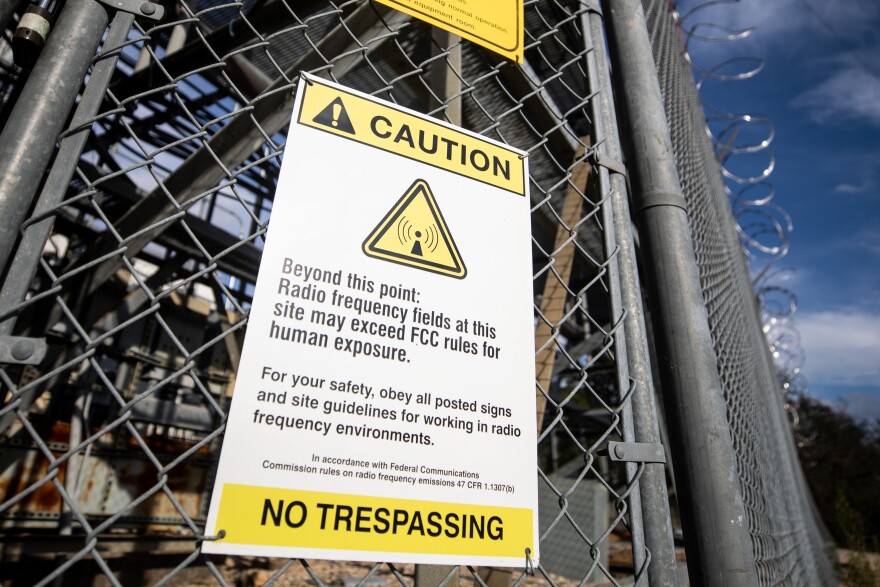This story was originally performed live at the Paramount Theatre in February. Our next live show is on Oct. 23 at Bass Concert Hall. Get your tickets now!
The towers in West Austin serve as giant landmarks in the day and, literally, beacons in the night. Day after day, month after month, year after year, these guardians watch over the city with a vigilance unlike any other.
But what exactly are these towers? Why are they there, seemingly all in one place?
Mary Halaney has lived in Austin for 31 years. She and other folks asked about the towers for our ATXplained project. But just asking KUT was not enough to satisfy the Halaney family’s curiosity. They had to get closer to the towers.
“It's kind of hard to find,” Halaney said after a trip up to see them. “There's a lot of winding roads, and you end up at the top, and there they are. And they've got like a wire fence around it with warning signs that say, ‘Don't come any closer than however many feet.’ It felt a little creepy up there, but then it's in the middle of this really nice upscale neighborhood.”
"Upscale neighborhood" is a bit of an understatement. Dell founder Michael Dell and his wife, Susan, own much of the land around the tower site. There are also a bunch of doctors, lawyers, real estate agents and other CEO-types who enjoy serene seclusion.
But let’s get back to Halaney.
A trip to the towers spurred more questions from her kids. Her daughter said the site reminded her of episodes of Welcome to Night Vale, a fictional podcast where a local radio host reads announcements about the oddities around town. Among them are several references to unexplained lights in the night sky.
Halaney’s kids also wanted to know if there were controversies surrounding the towers' placement.
"Did they use eminent domain?" Halaney asked.
Then their imaginations got ahold of them.
“My son says, ‘Why do I feel this spooky energy pulling me toward the towers?’” she said. “And then my daughter says, ‘Why have they appeared in my nightmares?’”
Information transmitters
The Halaneys’ impressions are not altogether wrong. The chain-link and barbed-wire veneer could be seen as the stuff of Netflix-inspired nightmares, a vibe that this is where the experiments take place in an episode of Stranger Things.
To answer their questions, I turned to KUT’s tower engineer, Cole McClellan. He has worked at UT for 56 years. He began work on radio towers before that as a teenager. He has forgotten more about broadcast towers than most people remember.

And that’s what those towers do: send and receive broadcast signals for radio, TV, cellphones, emergency management radio equipment, translators, ground repeaters, and backups for most of that.
Many of the towers stand more than 1,000 feet. They are all privately owned. NBC affiliate KXAN, for example, broadcasts from its own tower. But most broadcasters rent space on the towers. KUT and KUTX rent a spot from the American Tower Co.
The taller ones are fairly close in height to one another. The KXAN tower — at just over 1,300 feet — is the tallest structure in Austin. It stands almost twice as tall as Austin’s Jenga building.
Because they're so high, they need beacons to prevent planes from flying into them. What you see blinking red at night are lights about the size of a wedding cake. So planes avoid them in the day, the towers are legally required to be painted two shades, aviation orange and outside white (actual paint colors).
So why there?
“It was cheap out there,” McClellan said. “I think it was availability, the height and the access.”
Cheap land
With real estate these days, it might be difficult to wrap your mind around, but there was a time when people did not want to live in the hills of West Austin. Reaching back to the 1960s, the area around West Lake Hills was mostly poor and rural.

People there, colloquially known as “cedar choppers,” made a meager living chopping cedar trees for fence posts.
Back then, there wasn’t much value in the land, just a few minutes from downtown Austin. So broadcast companies easily swooped in to buy the spots they needed.
The towers stand on land that is about 900 feet above sea level. They are at the top of Buckman Mountain and nearby Mount Larson. While not especially large or distinctive, they are labeled as separate peaks on some topographical map websites.
These very tall things are on one of the highest points for a reason: to send direct radio and video signals to you — nearly everything you watch and hear — wherever you are.
Most of Austin’s radio, TV, satellite radio, emergency communications, mobile phone signals, and weather radio have some part of their operations here.
'Spooky energy'
Inside the fence, the scale of the towers boggles the mind. Looking up from the ground, it actually looks like they’re bending. If you look too long with some moving clouds, a little vertigo might follow.
At the base of each tower is a small building that houses equipment for every broadcaster using that particular tower. This requires tons of wiring and engineering to be sure the signals don’t bleed into one another. High voltage warnings are seemingly at every turn. So are radio frequency warnings.
And Halaney’s son might be onto something with the whole "spooky energy." Too much radio frequency exposure raises the body temperature, resulting in tissue damage.

Essential infrastructure
Despite the towers' importance, there are rarely more than a handful of people on-site at any given time. To most of us, the towers are just part of the scenery. We take for granted that whatever we need to see or hear or know can be seen, heard or known.
Until a crisis comes and you absolutely need the information coming out of them.
In February, ice crippled much of Austin’s infrastructure. People turned to their radios, TVs and phones to get important info.
Ice crumpled tree limbs — and a radio tower. Luckily, this was not the tower KUT leases. But it did knock out the power supply, forcing Cole and dozens of other engineers to maintain generators so the radio signals stayed on. KUT had to use its backup tower while repairs were made.
The West Austin radio towers may not be beautiful, but they’re there; when it’s more than 100 degrees outside, pouring down rain, in the freezing cold, high winds, and lightning, keeping us all in the know.











